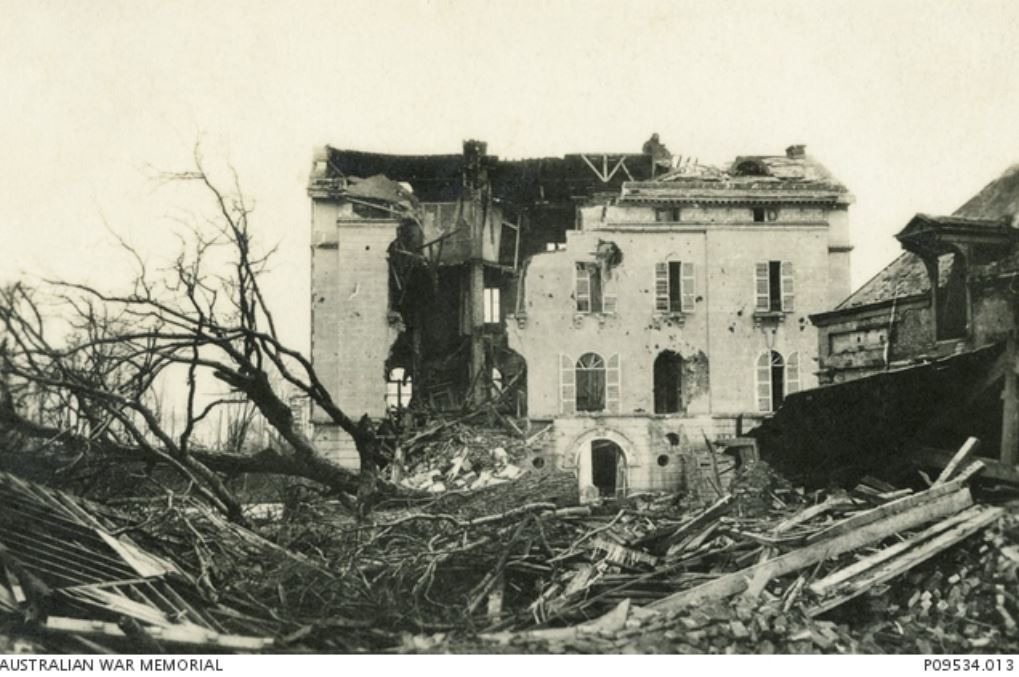Difference between revisions of "3rd Pioneer Battalion"
From Our Contribution
(→Battalion Personnel) |
(→Battalion Personnel) |
||
| Line 32: | Line 32: | ||
* [[Clarence Henry Batt]] 15 Apr 1916 - 7 Dec 1918 | * [[Clarence Henry Batt]] 15 Apr 1916 - 7 Dec 1918 | ||
* [[Ernest Albert Batt]] 15 Apr 1916 - 7 Dec 1918 | * [[Ernest Albert Batt]] 15 Apr 1916 - 7 Dec 1918 | ||
| − | * [[Charles John Mitchell]] | + | * [[Charles John Mitchell]] 3 Sep 1917 - 6 Jun 1918 |
* [[John Aubrey Nunn MC]] | * [[John Aubrey Nunn MC]] | ||
* [[Michael Dennis O'Rourke]] | * [[Michael Dennis O'Rourke]] | ||
Revision as of 01:00, 28 February 2021
 Shoulder patch | |
 January 1919 Billeted in remains of Chateau Nieppe near Armentieres. photo P09534.013 | |
Contents
Brief History
Formed in Victoria in March 1916 from volunteers drawn from Victoria, Queensland, South Australia, and Western Australia and was subsequently assigned to the 3rd Division.
Trained as infantrymen, they were also tasked with some light combat engineer functions, with a large number of personnel possessing trade qualifications from civilian life. As such, they were designated as pioneer units. At the same time, they could be pressed into the line to fight alongside regular infantry where required.
The battalion subsequently undertook further training in the United Kingdom before arriving in France in late 1916.
Their first action of note came around Messines in June 1917 when several of their companies were assigned to dig trenches in support of the attacking infantrymen. The remainder were charged with maintaining roads, supplying water anti-aircraft defense and tramway maintenance. Their next action was as participants in elements of the Third Battle of Ypres, especially Broodseinde. They spent the winter of 1917/18 around Messines supplying labour to maintain the tramway system and providing reinforcements to Engineering Companies.
During 1918, as for most of the Australian units they participated in the halting of the German advance at Villers-Bretonneux, the battle for Hamel, and the subsequent 100 Days Offensive. During this time they acted as Infantry from 22 August and completed their fighting with the attack on the Hindenburg Line and at the St Quentin Canal.
After the conclusion of hostilities, the battalion's strength dwindled as personnel were sent to England and elsewhere for educational courses to prepare them to return to civilian life. The battalion was formally disbanded in March 1919.
During the war, a total of 1,964 men served in the 3rd Pioneer Battalion; this includes the original enlistments and eight batches of reinforcements.[27] Of these, 140 were killed or died of wounds, 19 died from illness or from accident, 208 were gassed, and 619 were wounded in action.
Battalion Personnel
- Alfred Ernest Andrews 15 Apr 1916 - ?? Apr 1919
- Clarence Henry Batt 15 Apr 1916 - 7 Dec 1918
- Ernest Albert Batt 15 Apr 1916 - 7 Dec 1918
- Charles John Mitchell 3 Sep 1917 - 6 Jun 1918
- John Aubrey Nunn MC
- Michael Dennis O'Rourke
Battle Honours
No battle honours were subsequently awarded to the 3rd Pioneer Battalion – or any other First World War pioneer battalion – as there was no equivalent unit to perpetuate the honours when they were promulgated by the Australian Army in 1927.
Individual Honours
- 1 x Victoria Cross - (L/Cpl Walter Peeler)
- 1 x Officer of the Order of the British Empire
- 3 x Members of the Order of the British Empire
- 4 x Distinguished Service Orders
- 16 x Military Crosses
- 10 x Distinguished Conduct Medals
- 73 x Military Medals
- 9 x Meritorious Service Medals, and
- 3 x Mentions in Despatches
Notes
Content for the history and honours sections has come from a combination of Wikipedia and the Australian War Memorial websites.